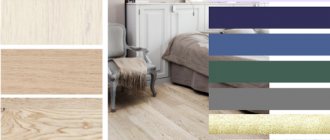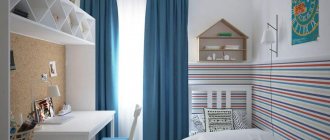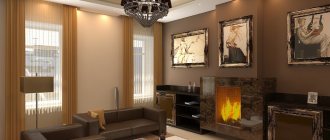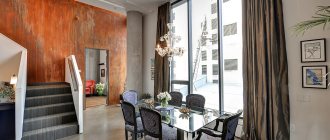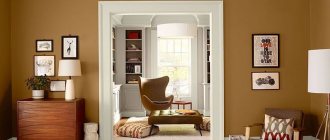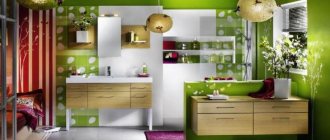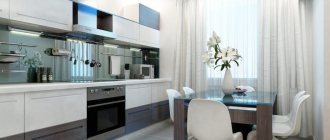Walnut-colored furniture is a universal option for most modern interiors. It looks rich and noble, fits organically into almost any interior style and goes well with a number of colors and shades.
Wall decoration and walnut table in the living room
Walnut wood, with its deep shade and expressive pattern, is often chosen not only for furniture, but also as the main material for the entire interior. A rich range of colors from light honey to dark mahogany allows you to create an unforgettable color in the interior of any room.
Walnut shades in the interior
Walnut furniture is brown in color with a reddish or grayish tint. Against this background, dark veins are clearly visible, due to which the material looks voluminous and textured. Walnut has many varieties:
- Italian;
- walnut;
- Milanese;
- Brazilian;
- Spanish;
- American;
- pecan.
Red walnut dining table and chairs
Designers most often classify all walnut furniture according to shade: red, gold, dark and light.
Furniture, doors, and parquet in walnut tones are widely represented on the market today. However, few people think about how to combine this material with other interior elements.
The wall in the living room is their walnut
Brown-honey walnut shades fit perfectly into any interior style. Modern trends in the design of a kitchen or dining room take well to the natural warmth of walnut, against which glossy facades, stainless steel household appliances, glass surfaces and built-in lighting contrast perfectly.
Using dark, deep shades of solid walnut, you can achieve a visual expansion of space and higher ceiling heights in the room. However, for this purpose, you should choose low pieces of furniture (chests of drawers and other modular options) in combination with light wall decoration and snow-white ceilings.
Walnut furniture suggests that this particular shade will become dominant when decorating the room. This means that warm and light shades of brown should be noted not only in furniture, but also in flooring and textiles. In addition, take care of additional lighting to prevent the room from looking faded and gloomy.
Designer walnut table
Combination of walnut with other colors and shades
When choosing walnut furniture, pay due attention to the combination of colors. So, combining walnut furniture with red, orange or lilac colors will add extravagance to the interior. If you prefer the classic English style in decor, then combine walnut with blue, burgundy and bottle green tones.
Cool nutty shades look better with white, blue, light green, and warm shades look better with cream, yellow, cornflower blue and khaki.
Partial walnut wall decoration in bathroom
The combination of walnut and beech will look very exotic. It is better to choose gray wallpaper for this tandem.
For soft armchairs and a sofa, choose light sand tones. Walnut-colored cabinets and bookcases will harmonize well with a beech coffee table.
When choosing walnut furniture for your interior, consider the following:
- Furniture should not merge with the walls. The color of the walls, floor and door should be lighter than the furniture.
- Walnut furniture looks best against yellow or green walls. Moreover, the palette of shades is very wide: from creamy to ocher and from pistachio to muted herbal.
- Walnut-colored furniture will not look organic in cold interiors. Especially if the room faces north. Walls, accessories, textiles - everything should be in warm colors.
Walnut bathroom vanity facade
Select walnut: a good option for the bedroom
The bedroom is a place where obvious accents are not required, no matter whether it concerns the floor, walls or furniture. Here we relax and the best environment for this is a calm, soft interior. Therefore, although the sorting of rustic wood with a rich content of knots is good in a living room or office in a country interior, it is not always appropriate in the bedroom. For the latter, select sorting is better suited - selected wood is almost even in texture with a minimum content of knots. The same applies to American walnut: it draws too much attention to itself and, if you want to emphasize contrast, slightly mute a light, cold interior, it is better to do this with a solid board made of select walnut
. Unlike its American “brother,” it has lighter wood, slightly more delicate tints of sapwood, and, sometimes, even a reddish tint. It is worth noting that the color of the walnut depends on the region of growth: the further south you go, the lighter the wood.
Italian walnut in the interior of the apartment
Italian walnut has gained particular popularity in Russia not only in the production of furniture, but also in the manufacture of floor coverings. This material is the most capricious, so when decorating the interior you should carefully think about color combinations. Basic rules for combining:
- Dark colors of furniture - light walls and floors.
- The most successful combination: Italian walnut and shades of yellow and green.
- No red "neighborhood".
- Accessories in warm colors.
Italian walnut seat
The best place to use Italian walnut color is the bedroom. Luxurious carved furniture and headboards will be ideally combined with pastel wall decoration, pale green curtains and a milky beige bedspread.
When arranging your kitchen, keep in mind that Italian walnut will be harmonious in combination with white, beige or yellow walls and a countertop of the same neutral shade.
In a classic living room with luxurious tapestries, curtains and carpets, furniture in Italian walnut color will look great. The peculiarity of furniture of this shade is that it really loves carpets.
Italian walnut corner cabinet
Milanese nut: positive mood and home comfort
Milanese walnut is a very livable color. It goes well with:
- products from the same array;
- cherry, bleached oak;
- warm and calm shades of a different range, for example, caramel, sand, ocher;
- gray, greenish, pink colors;
Dining table and chairs made of Milanese walnut.
Furniture of this color is amazingly combined with products made from genuine leather.
Milanese walnut is the color of comfort and tranquility. Interiors where this color scheme prevails are warm and homely.
Beautiful Milanese walnut chair
Burning Spanish nut
Spanish walnut (nogal), which came to us from Peru, is the darkest of all walnuts. Its color is amazing: dark chocolate wood with light stripes. At the same time, it is a very hard rock.
Spanish walnut chest of drawers
Dark chocolate shades of solid walnut look very expressive and contrasting, so there should not be too many such elements in the bedroom interior. If you choose Spanish walnut for a dressing table, bedside tables or to decorate a work area within a bedroom, then place this furniture against a light background. A pastel and even snow-white palette for finishing all surfaces of the room would be very appropriate here.
Spanish walnut wall
American walnut: luxury and respectability of the interior
American walnut is a symbol of luxury and respectability. This type of nut has a more uniform and rich texture. American walnut, characterized by its hardness and resistance to deformation, is used for the manufacture of luxury furniture.
American walnut parquet
The range of colors of American walnut is very wide: from light brown to chocolate tones. When decorating a room, combine furniture with light, soft colors. You can add warmer beech to the decor: this will add piquancy to the interior.
American walnut desk
The most popular shades of walnut
American walnut
Black, or American, walnut gets its name from its dark base, which can range in color from light brown to rich chocolate. At the same time, the outer layer of wood, lying directly under the bark, can be quite light, almost creamy, which allows you to create original furniture. Black veins are often visible on the surface of such wood.
Over time, a beautiful, peculiar coating becomes more and more apparent on the surface. The texture is straight and clearly defined. When decorating interiors, beech items are sometimes added to American walnut-colored items - this combination makes the room more interesting.
Photo: d1kxfday8czlm.cloudfront.net
Italian walnut
This wood is rich, dark red. The palette can go either towards brown shades or dark pink, even reddish. The spectacular texture with veins of various shapes allows you to produce stylish and beautiful furniture. Combinations with yellow and light shades of menthol, marsh, pea, olive, and light green are best suited for interiors of different styles. Combinations with red are undesirable. If there is an abundance of Italian walnut-colored furniture in the interior, elements of gray tones should be added to the decoration.
Photo: zhongguofeng.com
Milanese nut
Furniture and decoration items in Milanese walnut are lighter; they are appropriate in interiors with sand, cream, green, gray and pink tones of varying intensities. Many warm and cool decor colors go well with Milanese walnut, but they should not dominate. For a successful combination, it is enough to choose three or four of these shades in moderation.
Photo: greenmagazine.com.au
Spanish walnut
Spanish walnut, also known as nogal, is distinguished by its wood of the darkest and deepest chocolate color. Lighter stripes stretch across its entire surface. Because of this active effect, it is not recommended to saturate the room with decorations and objects in Milanese walnut. Unless it will be a very large room.
Photo: planete-deco.fr
Walnut furniture in the bedroom interior
One of the best furniture options is a walnut bedroom set. Usually it is decorated with complex carvings, gilding, and mirrors with a sandblasted pattern. The interior of a bedroom with such furniture should not be overloaded with unnecessary details. The ideal content is light walls and floors, olive curtains and a beige bedspread.
Walnut furniture in the bedroom
Lovers of minimalism should choose a simpler version of walnut furniture for their interior. However, even a simple wardrobe, bed or chest of drawers made of walnut looks stylish.
An original way to decorate a bedroom is to use wall panels behind the head of the bed. An accent wall created using walnut panels will serve as the semantic center of the room for sleeping and relaxing.
Walnut flooring and walls
Application of bog oak
Bog oak, like any other wood, must go through stages of processing. Before the product is manufactured, the wood undergoes special drying and storage. For bog oak, special standards are applied that are completely unsuitable for any other wood. The process of extracting the material and its preparatory processing significantly influence the cost of wood. Oak. Which has lain for quite a few years under water and has been dried is an expensive material. Due to non-compliance with all the rules for extracting and storing wood, it can lose its properties, due to which it completely loses its value. Thus, all the wood becomes unusable and is sent for firewood.
Attempts to restore the properties and characteristics of bog oak by returning it to a body of water will not yield results. It will be difficult to restore it to usable condition after being raised again.
Today, there are few specialists who know exactly the correct process for storing and drying bog oak. True professionals are able to create unique products from this type of wood. Added with carvings, they cost a lot of money.
Bog oak is a valuable material that is important to use correctly. It cannot be replenished artificially, since this takes centuries, and due to the critical state of the environment, it will no longer be such a valuable wood
Nut kitchen
In the interior of the kitchen, walnut furniture in the English style will look very impressive. You can choose an elegant set with natural facades and expensive handles, or you can choose a simpler solution. Any walnut-colored furniture will create coziness in the kitchen due to its natural warm shade. The room is immediately filled with light.
Walnut kitchen furniture
To decorate the kitchen walls, you can choose beige, yellow or a light shade of brown. If you want a more formal interior, go for the gray version of the walls. Remember that walnut does not go well with red. However, if you really want, you can place several red accessories in the kitchen. Buy, for example, burgundy-colored dishes.
Walnut kitchen countertop
Using walnut color for different interiors
As a rule, walnut tone is applicable in almost all modern design solutions
Attention should be paid to common interiors for residential premises:. Classic interior
This design is considered the most common today. Here it is advisable to use gentle, pleasant tones. An interior door and walnut-colored furniture in light colors are suitable for its implementation. As for the door leaf, it is allowed to use a dark walnut shade with additional decorative elements. The canvas can be either a traditional rectangular shape or made in the form of an arch. It is allowed to use decorative elements in the form of carvings or glass inserts
Classic interior. This design is considered the most common today. Here it is advisable to use gentle, pleasant tones. An interior door and walnut-colored furniture in light colors are suitable for its implementation. As for the door leaf, it is allowed to use a dark walnut shade with additional decorative elements. The canvas can be either a traditional rectangular shape or made in the form of an arch. The use of decorative elements in the form of carvings or glass inserts is allowed.
Classic style Execution style - modern Doors and furniture in walnut color
Products in the form of a portal
Interior doors - dark color Furniture To complete the conversation about such a shade as walnut, it is worth saying that its use will significantly save your finances, and the rich structure of the color will help you avoid a long search for the best option. Since such deciduous wood is noticeably cheaper than its direct competitors. American walnut is not used as often as an interior color, as this shade is more suitable for floor coverings.
Sliding doors Wood grain Shades
Exquisite walnut-colored furniture will become a worthy element of the interior in a room with any functional load, be it a kitchen, living room, bathroom or bedroom. When decorating a room, color combinations play an important role. Information about the features of walnut-colored furniture and the rules for combining it with other design elements will be useful when arranging your own home.
Walnut wood in the living room
All walnut species have a pronounced structure, so simple and laconic forms are usually used in the production of living room furniture. Classic, simple facades without decoration can become the highlight of the interior thanks to the beautiful texture of the material. It is better to choose plain light shades as a background.
Walnut floor and shelf in the living room
Honey walnut shades look organic with orange, light green, yellowish-ocher, and mustard colors. Walnut furniture in the living room is a luxury acceptable only for spacious and bright rooms. If your living room has panoramic windows, then in addition to the furniture, you can use walnut finish on the walls and even the ceiling. But even in a spacious living room, leave at least one wall with a light finish. Let it become an accent within this room. To finish the floor, use a board made of natural material in a walnut wood shade. A harmonious completion of the living room look will be a coffee table matched to the color of the laminate.
Chest of drawers with walnut front in the living room
Another possibility of using walnut wood in the living room interior is the space around the fireplace:
- built-in shelving;
- frames for paintings, mirrors or photographs above the fireplace.
The luxurious color of the wood and the fire in the fireplace together will look very harmonious.
Walnut and glass coffee table
Walnut furniture in the office, hallway, dining room
And in these rooms there is a place for walnut furniture! The office can be decorated in a classic style. To do this, choose beige paint or wallpaper for the walls, lay a discreet carpet on the floor, place a few vases and get a classic interior.
Walnut desk
Any elements made of walnut wood, be it a chest of drawers in the hallway, dining groups in the dining room or furniture in the office, are real works of art. And they require a decent environment. Walnut furniture goes well with:
- carpets;
- heavy curtains;
- tapestries in gilded frames;
- Chinese vases,
- expensive porcelain.
If you want to recreate the traditional English style in the interior of your office, then combine walnut furniture with blue, bottle green, and emerald shades. Warm shades of furniture will balance the cool palette of finishes, and together they will create a harmonious, but at the same time original design of the workplace.
Light walnut table
Wood colors - features of choice and painting technology
All photos from the article
It is difficult to live without the use of wood in the construction and furnishing of a home. Even if all the supporting structures are made of metal or concrete, finishing materials made of wood will still be used, or the furniture will be made of wood. Today you can purchase almost any wood, including valuable species, so it’s a good idea to understand the color palette.
Different colors of wood
About the color scheme
More than a dozen shades can be distinguished, and the name of the corresponding wood species is used to designate each of them. For example, the color of mahogany wood means a reddish-brown hue. Over time, mahogany wood itself acquires a richer color and becomes even more beautiful.
This is what mahogany wood looks like
Ordinary cherry is quite close to mahogany; depending on the age of the wood and growing conditions, the wood can have a shade from dark red to light with golden. So the color of cherry wood is often confused with mahogany.
Cherry can resemble mahogany
Wood itself has an excellent appearance, so often when processing it is enough to simply reveal the texture and protect the surface from fading, although no one has canceled paint treatment. Sometimes this can be used to achieve a great visual effect.
When choosing a suitable shade, you need to understand that even within the same color there are a lot of shades.
In addition, they may differ depending on the manufacturer:
- for example, the color of walnut wood in the case of a parquet board provides for a change in shade from beige to “black coffee”. But when designating paint, this designation refers to a rich brown shade;
- under the designation “pine” in the palette there is a rich yellowish color;
Note! There may be designations “young pine” - a lighter color and “old pine” - richer and slightly darker.
- but under the designation “mahogany” hides a rich paint with a dark red tint. The wood of this species has exactly this shade, hence the name;
- Wenge color is also popular in finishing; this wood is rich in color, but falls a little short of complete blackness and upon closer examination the original texture is visible. Paint, of course, will not give such an effect, but in shade it is very close to this wood;
- The color ebony is as close as possible to pure black. Ebony wood can be either jet black or deep gray in color, depending on the age and how close to the core of the trunk the sample was taken. The shades of paint in this case range from rich gray to almost black.
When choosing paint materials, you need to understand that it is not at all necessary to paint the surface until a monochromatic surface is obtained. Sometimes it is much better to simply emphasize the texture, perhaps tint the surface, but not completely paint over it
Sometimes it's better to just show the texture
About painting technology
In addition to the correct choice of paint color for wood, painting technology is of great importance. Only in this case the paint will not peel off several months after painting.
Choosing color and painting wood
When painting externally and internally, you will have to choose between glazing and covering compounds. The former protect the wood from moisture and insects, but the texture remains visible. As for covering compounds, they form an opaque layer on the surface.
The choice of paint color depends on many factors; when painting surfaces inside the house, the color scheme of wood paints is selected taking into account the overall design of the room. For example, when decorating the kitchen of a timber house in the Provence style, preference is given to light shades, but dark shades (mahogany, ebony, wenge, etc.) are not used at all.
In the photo - a kitchen in Provence style
When painting the exterior of a house, there are more options, such as:
- light, calm colors (beige, white, etc.). Finnish houses are usually decorated in exactly this color scheme;
Note! When using light shades, you can combine it with dark inserts. This will make the house look more impressive.
- it is allowed to use rich shades, for example, the color of teak wood will give a reddish tint after painting;
- You can use other shades, for example, green. You just need to take into account that the paint consumption should be higher so that the wood texture does not show through.
Greenish tint of the house
Also, when choosing the color of wooden houses, you should take into account the surrounding environment. If the colors of neighboring buildings are in calm, light colors, then it makes sense to choose the same shade. In this case, using bright colors will be unnecessary; the house will simply look ridiculous against the background of its neighbors.
As for painting wood with your own hands, when doing exterior work you should adhere to the following recommendations:
- do not quit work halfway, then the border between areas will be noticeable;
- paint under normal conditions - low humidity, direct sunlight does not fall on the paint;
- Before applying the next layer, wait for the previous one to dry.
It's better to paint the whole house at once
When working inside the house, the instructions require:
- provide good ventilation;
- thoroughly sand the surface before painting;
- in order to prevent the paint from being absorbed into the wood, it must first be primed;
- To obtain an even, rich color, 3 or more layers of paint may be needed. The drying time for each layer depends on the type of paint.
It is important to understand that the final result largely depends on the type of surface. For example, the color walnut applied to a board with an expressive texture in 1 layer will give an interesting effect - the texture of the wood will be visible, so it will seem that the board is really made of walnut. But if you apply paint to a sheet of chipboard, you will get a solid, even color.
Experiments with paint
Sometimes the desired effect cannot be achieved by simply painting or applying varnish to a wooden surface. In this case, you have to experiment and combine different compositions.
Note! It is advisable to carry out experiments on an unnecessary piece of wood. Otherwise, the price of such creativity will be too high.
This technique is often used when it is necessary to age wood or achieve the effect of bleached wood.
To get the desired effect you need:
Removing soft fibers
- clean the surface of small sawdust;
- then the fun begins - apply 1 thin layer of light paint, wait until it dries;
- protruding hard fibers will remain unpainted, imitating an old surface. A couple of layers of varnish can be applied on top to protect the surface from abrasion and fading.
Result of effort
A combination of shades for the same purpose is also possible. This does not mean mixing different colors, but sequential coloring in different shades. Any colors of wood paints can be combined in this way, the main thing is to ensure that one shows through from under the other, creating the illusion of wear and tear received over years of use.
In conclusion
Choosing the right paint for wood, and working with it, is a whole science. The selected shade should fit perfectly into the interior of the house; this can sometimes be difficult to achieve. Fortunately, the color palette of modern paints and varnishes is so rich that there shouldn’t be any problems with choosing.
The video in this article describes the nuances of painting the outside of a wooden house. You can ask any questions about choosing paint for wood in the comments to this article.
